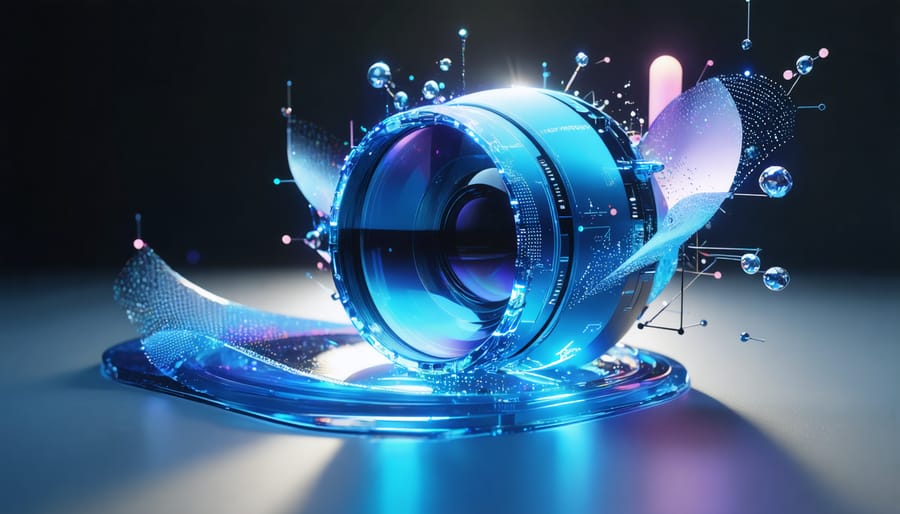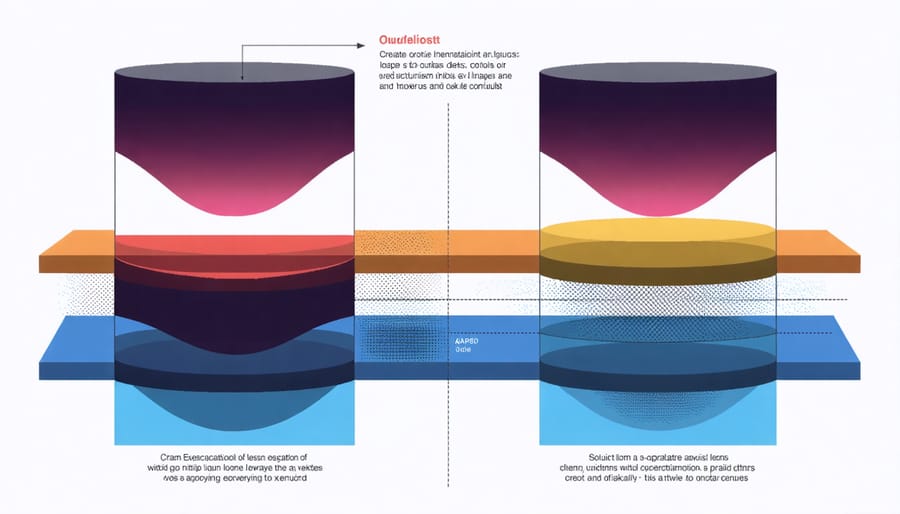
Revolutionary advances in lens technology are reshaping photography faster than ever before, merging cutting-edge physics with camera sensor technology to create imaging possibilities that seemed impossible just years ago. Liquid crystal lenses now reshape themselves instantly without moving parts, allowing photographers to focus from macro to infinity in milliseconds. Metamaterial-based optics, thousands of times thinner than traditional glass elements, are enabling smartphone cameras to match the performance of professional DSLR lenses. Perhaps most exciting is the emergence of computational optics, where artificial intelligence works in real-time with new lens designs to correct aberrations and enhance image quality far beyond what traditional optics can achieve.
These innovations aren’t just laboratory curiosities – they’re already appearing in professional gear and even smartphone cameras, fundamentally changing how we capture images. For photographers, this convergence of optical physics, materials science, and digital processing means sharper images, faster focusing, and creative possibilities that were previously confined to science fiction. The future of photography isn’t just about better lenses – it’s about smarter ones.
Liquid Lens Technology: The Future of Autofocus
How Liquid Lenses Work
Imagine a lens that can change its shape and focus without any moving parts – that’s exactly what liquid lenses do. At their core, liquid lenses use two immiscible fluids (typically water and oil) with different optical properties, contained within a small chamber. When an electrical voltage is applied, these fluids change their shape at the interface, effectively altering the lens’s focal length.
The principle behind this technology is called electrowetting, where electrical charges modify how liquids interact with a surface. Think of it like a water droplet on a leaf – when you apply voltage, the droplet’s shape changes predictably and controllably. In liquid lenses, this shape change happens at the interface between the two fluids, creating different optical properties.
What makes liquid lenses particularly fascinating is their speed and precision. They can adjust focus in milliseconds – much faster than traditional mechanical focusing systems. They’re also incredibly durable since they have no moving parts to wear out or break.
The technology finds applications beyond just cameras. From smartphone cameras to medical endoscopes, liquid lenses are revolutionizing optical systems. For photographers, this means potentially smaller, more reliable lenses with lightning-fast autofocus capabilities. Some manufacturers are already incorporating this technology into industrial cameras, and we’re likely to see it appear in consumer cameras in the coming years.

Real-World Applications
New lens technologies are rapidly transforming the photography landscape, building upon the remarkable evolution of digital photography. Professional sports photographers are already embracing liquid lens technology to capture split-second moments with unprecedented clarity. These adaptive lenses allow for instant focus adjustments, proving invaluable during fast-paced sporting events and wildlife photography.
In architectural photography, metamaterial lenses are making waves by enabling ultra-wide-angle shots without the typical barrel distortion. Several leading real estate photography firms have integrated these lenses into their workflow, producing more accurate representations of interior spaces.
Computational optics are finding their way into smartphone cameras, where manufacturers are combining multiple small lenses with advanced algorithms to achieve results that rival traditional DSLR setups. Portrait photographers are particularly excited about the potential of hybrid optical-computational systems that can achieve extremely shallow depth of field effects without bulky equipment.
Looking ahead, researchers are developing “smart lenses” that can automatically adjust their properties based on environmental conditions. Imagine a lens that automatically compensates for atmospheric distortion during astrophotography or adjusts its coating to reduce glare during golden hour shoots. These innovations aren’t just theoretical – prototype versions are already being tested by select photographers in the field, promising to revolutionize how we capture images in challenging conditions.
Computational Optics: When Software Meets Glass
AI-Powered Aberration Correction
Artificial intelligence has revolutionized many aspects of photography, and lens technology is no exception. Machine learning algorithms are now being employed to correct optical aberrations that have traditionally plagued photographers, from chromatic aberration to barrel distortion.
Modern AI-powered lens correction systems analyze thousands of sample images to learn how specific lens models behave under various conditions. This learning enables the software to predict and correct distortions in real-time, even before you press the shutter. For instance, when shooting architecture with a wide-angle lens, the AI can automatically compensate for perspective distortion, ensuring straight vertical lines remain parallel.
What makes this technology particularly impressive is its ability to adapt and improve over time. As more photographers use these AI-enhanced lenses, the algorithms become increasingly sophisticated at identifying and correcting specific aberrations. Some manufacturers have even implemented AI systems that can recognize different shooting scenarios and apply appropriate corrections automatically – whether you’re shooting landscapes, portraits, or macro photography.
The practical benefits are substantial. Photographers can now use more affordable lenses and still achieve professional-quality results, as the AI compensation helps overcome minor optical imperfections. This is especially valuable for photographers working with vintage lenses, where the software can correct for age-related degradation while preserving the unique character of the glass.
However, it’s worth noting that AI correction isn’t about completely transforming the image. Instead, it subtly enhances optical performance while maintaining the natural characteristics that make each lens unique. This balance between correction and preservation ensures that photographers can still achieve their creative vision while benefiting from improved technical performance.

Software-Hardware Integration
Modern lens technology represents a perfect marriage between precision optics and sophisticated software, ushering in a new era of digital innovation in photography. Gone are the days when a lens was just a collection of glass elements; today’s advanced optics work in harmony with powerful algorithms to deliver unprecedented image quality.
At the heart of this integration is computational photography, which uses software to enhance and sometimes even reimagine what traditional optics can achieve. For instance, the latest smartphone cameras compensate for their physical limitations by employing AI-driven algorithms that can simulate bokeh effects and correct optical distortions in real-time.
Professional camera systems are following suit, with manufacturers developing smart lenses that communicate extensive metadata to the camera body. This data includes not just focal length and aperture settings but also detailed lens characteristics that help the camera’s processor optimize image quality. Some systems can even automatically correct for focus breathing during video recording or compensate for atmospheric distortion in challenging shooting conditions.
Perhaps most exciting is how this integration enables features that were previously impossible with optical solutions alone. Focus stacking, perspective correction, and even real-time aberration compensation are now possible thanks to the seamless collaboration between hardware and software components.
Metamaterial Lenses

Breaking Physical Limitations
Traditional lens design has always been constrained by the fundamental laws of physics – or so we thought. Enter metamaterials, the game-changing technology that’s rewriting the rules of optics. These engineered materials possess properties not found in nature, allowing lens manufacturers to overcome limitations that have frustrated photographers for generations.
Think of metamaterials as tiny structures, smaller than the wavelength of light itself, arranged in precise patterns. This microscopic architecture enables them to manipulate light in ways that conventional glass elements simply cannot. For instance, while traditional lenses struggle with chromatic aberration due to different wavelengths of light bending at varying angles, metamaterial lenses can control these wavelengths with unprecedented precision.
One of the most exciting breakthroughs is the ability to create flat lenses that perform as well as or better than their bulky conventional counterparts. These ultra-thin optics, sometimes just micrometers thick, can achieve the same light-bending capabilities as traditional curved lenses. This means future camera lenses could be dramatically smaller and lighter while maintaining or even improving image quality.
The technology also promises to eliminate common optical issues like spherical aberration and coma, leading to sharper images across the entire frame. While currently in the early stages of commercialization, metamaterial lenses represent a fundamental shift in how we approach optical design, potentially revolutionizing everything from smartphone cameras to professional telephoto lenses.
Current Research and Future Potential
The landscape of lens technology is evolving at an unprecedented pace, with several groundbreaking developments currently in research labs worldwide. Scientists at MIT are making significant strides with metalenses, ultra-thin lenses that use nanostructures to manipulate light. These could potentially revolutionize smartphone cameras by dramatically reducing lens thickness while improving image quality.
Liquid lens technology is another fascinating area of research, where electrical charges control the shape of liquid elements to achieve instant focusing. Major manufacturers like Canon and Nikon are exploring this technology for its potential to eliminate moving parts in autofocus systems, promising faster and more reliable performance.
Perhaps most exciting is the development of adaptive optics, originally designed for astronomy, now being miniaturized for consumer cameras. These systems use deformable mirrors or liquid crystal arrays to correct optical aberrations in real-time, potentially offering perfect sharpness across the entire frame.
Looking ahead, researchers are working on “smart lenses” that incorporate artificial intelligence directly into the optical elements. These could automatically adjust their characteristics based on shooting conditions and even learn from the photographer’s preferences over time.
While some of these technologies are still years away from commercial release, they represent the future of photography, promising lighter, more capable lenses that could fundamentally change how we capture images.
Practical Impact for Photographers
These emerging lens technologies aren’t just laboratory curiosities – they’re set to revolutionize how we approach photography in the field. For photographers who’ve grown accustomed to traditional glass elements, these innovations offer exciting new possibilities for both creative expression and professional photography applications.
The most immediate impact will be in lens size and weight. Imagine carrying a single compact lens that can replace several heavy pieces of glass in your bag. Liquid lens technology, in particular, means you could have a zoom range from wide-angle to telephoto without changing lenses, while maintaining excellent image quality throughout the range.
For nature and wildlife photographers, these advances translate to faster autofocus and more precise tracking of moving subjects. The responsive nature of liquid elements means near-instantaneous focus adjustments, potentially capturing moments that might have been missed with conventional focusing systems.
Studio photographers will benefit from the improved aberration control offered by metamaterial lenses. Portrait sessions could see better bokeh effects and more natural skin tones, thanks to superior chromatic aberration management. The reduced distortion at wide apertures means shooting at f/1.4 or even wider becomes more practical for everyday use.
Event photographers will appreciate the enhanced low-light performance. The increased light transmission efficiency of these new technologies means better results in challenging lighting conditions without pushing ISO levels too high. This could be game-changing for wedding photographers working in dimly lit venues or photojournalists covering evening events.
For landscape photographers, the combination of lighter weight and improved edge-to-edge sharpness means easier hiking with gear and better overall image quality. The reduced focus breathing in video applications also makes these lenses more versatile for hybrid shooters who need to capture both stills and motion.
Perhaps most excitingly, these technologies will likely lead to new creative possibilities we haven’t even imagined yet. Just as tilt-shift lenses opened up new perspectives in architectural photography, these innovations could inspire entirely new shooting techniques and styles.
The rapid evolution of lens technology is reshaping the future of photography in ways we could only dream of a decade ago. From liquid lenses that can instantly adjust their shape to metamaterial-based optics that challenge conventional physics, these innovations are not just incremental improvements – they represent a fundamental shift in how we capture images.
As computational photography continues to merge with traditional optics, we’re entering an era where the distinction between hardware and software becomes increasingly blurred. The next generation of lenses will likely be smarter, more adaptable, and more compact than ever before, while delivering unprecedented image quality and creative possibilities.
For photographers, this means more versatile tools that can adapt to various shooting conditions without changing lenses. Professional photographers will benefit from enhanced reliability and performance, while enthusiasts will find these technologies making advanced techniques more accessible. The miniaturization of powerful optics will also continue to revolutionize mobile photography, bringing professional-grade capabilities to everyday devices.
Looking ahead, we can expect to see further integration of artificial intelligence in lens systems, more sustainable manufacturing processes, and possibly even self-healing lens coatings. While traditional glass elements will remain important, these emerging technologies will complement and enhance rather than replace them entirely, creating a more diverse and capable photographic ecosystem for all users.





















